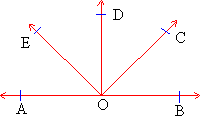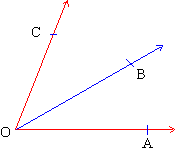Measure of an angle : Every angle has a
measure. It is measured in degrees from 00 to 1800
and is represented as m Ð. A line
is also an angle because it satisfies the definition of having two
rays going in different ( in this case opposite ) directions with
a common end point ( figure 1.14 ).

Figure 1.14
 is also Ð AOB and m Ð AOB = 1800 is also Ð AOB and m Ð AOB = 1800

Figure 1.15
All rays starting from O and going above line AB form angles with  such that their measure is between 00 and 1800. eg. Ð COB , Ð DOB and Ð EOB. such that their measure is between 00 and 1800. eg. Ð COB , Ð DOB and Ð EOB.
Angle addition property : Two angles with a common side and a common vertex are adjacent if their interiors are disjoint . The measures of two adjacent angles can be added to find the measure of the resultant angle. This is called the angle addition property. With reference to figure 1.15 m Ð COB + m Ð DOC = m Ð DOB.
Angle Bisectors : The ray which passes through the vertex on an angle and divides the angle into two angles of equal measure is called the bisector of that angle. Of the two angles ( figure 1.16 ) Ð AOB and Ð COB are equal in measure then  is called the bisector of Ð COA. Just as every line has only one midpoint every angle has only one bisector. is called the bisector of Ð COA. Just as every line has only one midpoint every angle has only one bisector.

Figure 1.16
|